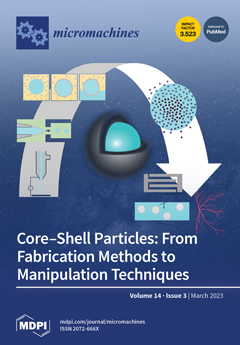Ta
2O
5 coatings were created using micro-arc discharges (MDs) during anodization on a tantalum substrate in a sodium phosphate electrolyte (10 g/L Na
3PO
4·10H
2O). During the process, the size of MDs increases while the number of
[...] Read more.
Ta
2O
5 coatings were created using micro-arc discharges (MDs) during anodization on a tantalum substrate in a sodium phosphate electrolyte (10 g/L Na
3PO
4·10H
2O). During the process, the size of MDs increases while the number of MDs decreases. The elements and their ionization states present in MDs were identified using optical emission spectroscopy. The hydrogen Balmer line H
β shape analysis revealed the presence of two types of MDs, with estimated electron number densities of around 1.1 × 10
21 m
−3 and 7.3 × 10
21 m
−3. The effect of MDs duration on surface morphology, phase and chemical composition, optical absorption, and photoluminescent, properties of Ta
2O
5 coatings, as well as their applications in photocatalytic degradation of methyl orange, were investigated. The created coatings were crystalline and were primarily composed of Ta
2O
5 orthorhombic phase. Since Ta
2O
5 coatings feature strong absorption in the ultraviolet light region below 320 nm, their photocatalytic activity is very high and increases with the time of the MDs process. This was associated with an increase of oxygen vacancy defects in coatings formed during the MDs, which was confirmed by photoluminescent measurements. The photocatalytic activity after 8 h of irradiation was around 69%, 74%, 80%, and 88% for Ta
2O
5 coatings created after 3 min, 5 min, 10 min, and 15 min, respectively.
Full article






